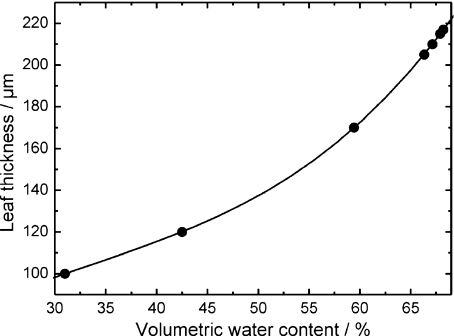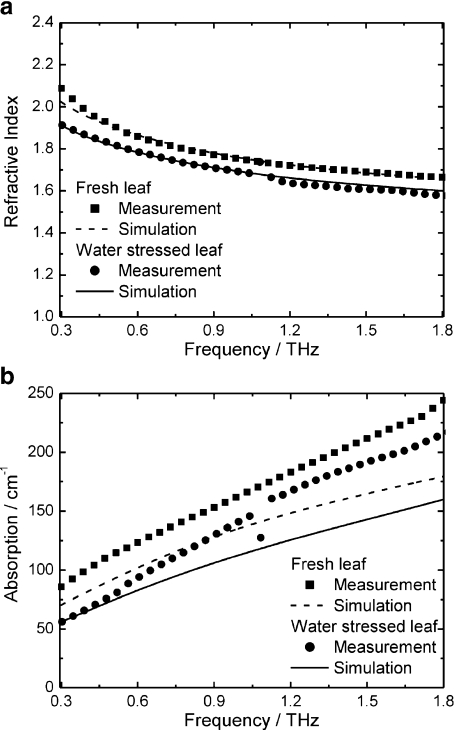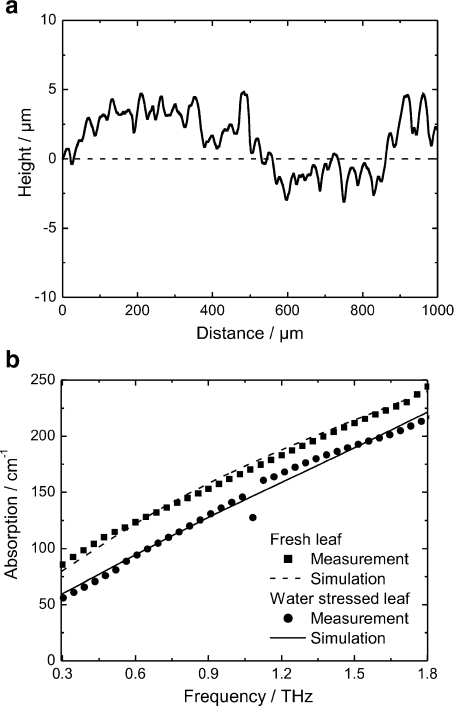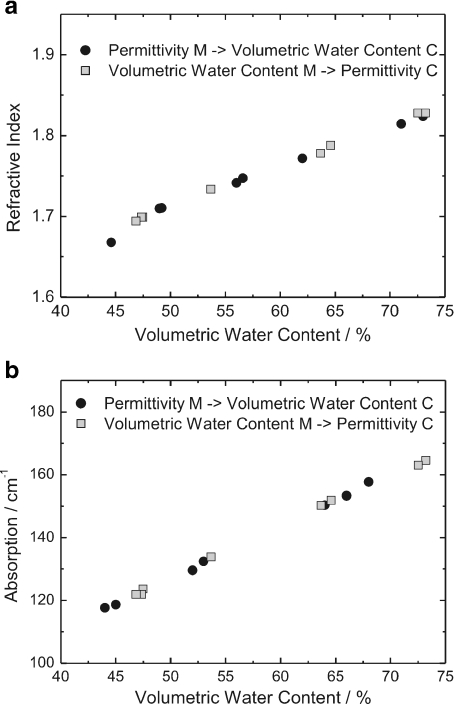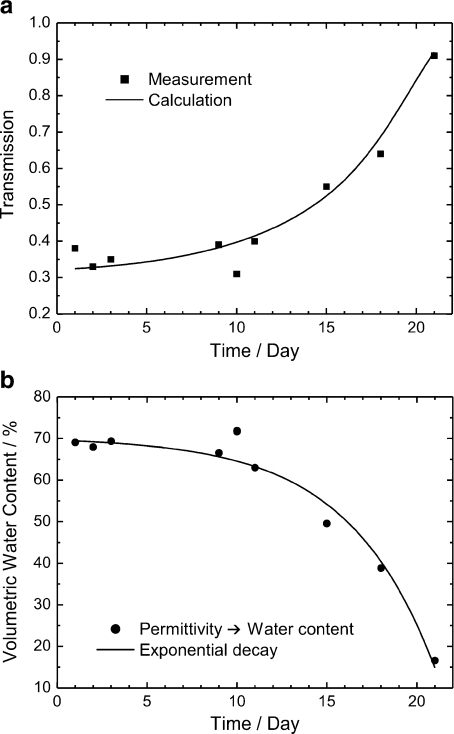Abstract
We present an electromagnetic model of plant leaves which describes their permittivity at terahertz frequencies. The complex permittivity is investigated as a function of the water content of the leaf. Our measurements on coffee leaves (Coffea arabica L.) demonstrate that the dielectric material parameters can be employed to determine the leaf water status and, therefore, to monitor drought stress in plant leaves. The electromagnetic model consists of an effective medium theory, which is implemented by a third order extension of the Landau, Lifshitz, Looyenga model. The influence of scattering becomes important at higher frequencies and is modeled by a Rayleigh roughness factor.
Keywords: Terahertz time-domain spectroscopy, Dielectric mixture, Permittivity model, Leaf water content, Drought stress, Coffea arabica
Introduction
The evaluation of leaf water content is of great importance to farmers and horticulturists as well as to scientists like plant physiologists or biochemists. It provides valuable information in irrigation management and helps to avoid plant drought stress. Owing to the growing scarcity of water in an increasing number of regions of the world, knowledge of the water content in plant leaves will become increasingly important to control its usage in irrigation.
The state-of-the-art techniques in determining leaf water status can be divided into two groups, destructive and nondestructive. An example of the former is a thermogravimetric measurement, which is the most prominent method and offers high reliability as well as ease of handling: the water content is calculated by the weight difference of fresh and fully dried samples. However, for long-term studies of the same plant, nondestructive methods are required. Among these techniques, contactless measurements are preferable, for example those which employ infrared radiation or microwaves. Nuclear magnetic resonance has also been adopted for measurements of leaf water content [1]. We will, however, concentrate on the first two techniques since the last one requires complex systems with large electromagnets and is, therefore, not suitable for the development of compact field instruments in the future.
Microwave measurements refer to the change in the permittivity of the leaf with varying water content. Models to describe the dielectric constant have been successfully developed up to a frequency of 100 GHz [2–4]. However, the permittivity, especially at lower frequencies, is strongly affected by the salinity of the water within the leaf [5]. Furthermore, due to the relatively large wavelength, the resolution for imaging measurements is limited. The evaluation of leaf water status based on infrared radiation is usually carried out in reflectance geometry [6–10]. Although this area of research is more than 20 years old, there is still an ongoing discussion of the suitability of the employed spectral indices [9]. Furthermore, extraneous variables also have an influence on the reflectance-based measurements of leaf water content [10].
Recently, terahertz radiation has been employed for the first time to image the water distribution within the leaf of a common house plant [11]. This radiation, which covers a frequency range between 0.1 and 3 THz, is very sensitive to water. Due to its smaller wavelength compared with microwaves, it offers a better spatial resolution. Furthermore, the influence of dissolved salts on the permittivity of water is low. In a first model by Hadjiloucas et al. [12], the influence of varying water content in plant leaves on the absorption coefficient was described. In this approach, scattering losses were neglected since the measured data ends at frequencies of 500 GHz. Furthermore, this model does not provide the refractive index, which is necessary for a complete description of the permittivity.
Here, we present a model which allows for the simultaneous calculation of the refractive index n and the absorption α of plant leaves. For the evaluation of the leaf water content, either n or α can be employed. We implement a Rayleigh roughness factor in our model to account for scattering losses, which have a crucial influence on the absorption, especially at higher frequencies above 1 THz. We successfully employ the model to calculate the refractive index and the absorption coefficient of fresh and stressed coffee leaves at frequencies between 0.3–1.8 THz. Furthermore, we use this model to evaluate changes in the leaf water content of a particular C. arabica plant during a long-term study.
Experimental setup and sample preparation
Different coffee plants with a similar size and number of leaves were investigated in the fundamental study. Some of these plants were subjected to drought stress, while others were watered as regularly as before. The plants were considered to be stressed if signs of wilting were apparent. Leaves with a similar size were detached from the fresh and drought-stressed plants and measured with a standard THz time-domain spectrometer. The corresponding setup and the extraction of the material parameters n and α are described in detail in [13, 14]. For the fundamental study, leaves at different stress levels were investigated. The thickness of the leaf was determined by means of a micrometer screw; a gentle turning of the screw assures an undamaged leaf surface. In the next step, the water content of the leaf was evaluated. For this, a round piece with a diameter of 13 mm was cut from the leaf and dried. The mass change from the beginning to the end of the drying process accounts for the water loss. A circular sample shape (disk) was selected to associate the water loss with a fixed leaf surface.
For the investigated leaves of this study, the leaf thickness increases continuously with rising water content. Figure 1 depicts the leaf thickness as a function of the water content. The solid line represents a polynomial fit of the measured data and may serve as a guide to the eye. These findings agree well with the results presented in [12]. Yet, as already mentioned by Hadjiloucas et al. [12], the determination of the leaf thickness represents just an indirect measurement of the water content. Errors may arise if the determination of the leaf water content is based only on the thickness measurements. Therefore, an alternative method, i.e., investigation at THz frequencies, is required.
Fig. 1.
Leaf thickness of a coffee leaf at different volumetric water contents
The dried leaf disk consists of air and the remaining solid plant material. To evaluate the air content, the disk was pressed for 1 min under a load of 10 tons. The change in the thickness was attributed to the loss of air within the dry leaf disk. The dried leaves had a thickness between 60 to 90 μm, and after pressing, the thickness of all leaves was around 31 ±1 μm. The weight was 5 mg and no weight loss was observed during the pressing process. This result demonstrates that the absolute amount of solid plant material remains constant if the plant is subjected to drought stress. The pressed disk was additionally measured in a THz time-domain spectrometer to determine the permittivity of the solid plant material. The analyses of solid plant material disks from various plants revealed very similar results, demonstrating that their permittivities exhibit only slight variations.
It should be noted that the absolute thickness of the solid plant material may slightly change by varying the pressing conditions. However, this results in a different value of the permittivity of the material. This may only affect the air content but not the water content which is the aim of this study.
The volume concentrations ξ of water, air, and solid plant material (with the indices W, A, S, respectively) can be evaluated by the formulas
 |
where ρW is the specific gravity of water and A the leaf’s area (13 mm diameter disk), T is the thickness and M represents the mass. The indices 1, 2, 3 denote the measured values before and after drying and after pressing, respectively.
Additionally to the fundamental investigation, a long term study was performed. One coffee plant was drought-stressed for 21 days, and one leaf was measured in the THz spectrometer at certain days. The thickness was recorded as well. The results are shown in Section 4.
Theoretical model and experimental results
A leaf consists of a complex biological structure of tissues and different biomolecules like cellulose and other carbohydrates, proteins, and many other high and low molecular weight compounds. Yet, describing the structure and composition of leaves in detail is not essential for our investigation. It is more useful consider only those components which actually interact with the electromagnetic wave. We identified the main substances to be water, air, and solid plant material. The last one summarizes everything that can be found in a pressed and dry leaf. We evaluated the permittivity of solid plant material (see Fig. 2) and did not observe any pronounced feature in the spectrum. Therefore, no further subdivision of this component is necessary.
Fig. 2.
Refractive index (a) and absorption coefficient (b) of solid plant material: measurement (circles) and regression curve (solid line)
The permittivity of a multicompound mixture can be described by an effective medium theory (EMT). One widely-employed EMT is the Landau, Lifshitz, Looyenga model (LLL) [15], which characterizes mixtures consisting of irregular-shaped particles. Therefore, it is well-suited as a dielectric model of a plant leaf. However, the LLL model is just capable of describing the effective permittivity of a compound consisting of two components. Thus, we provide a third-order extension of the LLL model to account for the three parts of the leaf:
 |
where ξ and ε are the concentration and the permittivity of the components, respectively. The index L, W, S, A refers to the leaf, the water, the solid plant material, and the air, respectively.
We derived the pure water permittivity by a dual Debye model [16]. The dielectric properties of the solid plant material were determined by TDS measurements on the pressed and dried leaves as described in Section 2. Figure 2 shows the refractive index and the absorption coefficient of the solid plant material. The results scatter somewhat around the solid line; therefore, a least squares approximation (solid line) was used as an input for the dielectric model.
The measured refractive index and the absorption coefficient of two selected leaves, a fresh and a drought-stressed one, are depicted in Fig. 3. We observe a strong abnormal dispersion of the refractive index which is attributed to the large water content in the leaf. The absorption of fresh leaves exceeds 100 cm − 1 for the same reason. Both dielectric parameters differ significantly for fresh and water-stressed leaves. Thus, they are well-suited for the evaluation of the leaf’s water content. Figure 3 shows the simulated results for the refractive index and the absorption coefficient as well. We find a good agreement between measurement and simulation for the refractive index, whereas a strong deviation for the absorption coefficient is observed. The discrepancy increases with increasing frequency. Thus, we attribute this deviation to the fact that scattering losses have not been implemented yet in this model. This aspect will be addressed in the remainder of this section.
Fig. 3.
Refractive index (a) and absorption coefficient (b) of a fresh and a drought-stressed leaf: measurement (squares and circles) and simulation (dashed and solid line)
The complex permittivity of the leaf εL includes the absorption losses. However, the scattering at the leaf’s interfaces is neglected by the above approach. For a better description of the leaf’s permittivity, we summarize the two contributions, absorption and scattering losses, to determine the total absorption coefficient:
 |
The influence of scattering due to surface roughness can be described by a Rayleigh roughness factor [17]. To account for the frequency-varying reflectivity, we additionally take the contrast in permittivity Δε into account, which leads to the scattering-induced apparent absorption:
 |
with
 |
Here, τ denotes the degree of surface roughness expressed by the standard deviation of the height profile, θ is the angle of incidence, λ the free space wavelength, and T the thickness of the leaf. We determined several height profiles from the front and back surface of a leaf and obtained standard deviation values between 1.89 and 7.34 μm. One typical height profile is shown in Fig. 4a. Therefore, we assume for τ a value of 3.5 μm in our calculations, which fits well to the dimensions of the surface structure of these leaves.
Fig. 4.
Height profile of a leaf (a) and absorption coefficient (b) including scattering losses of a fresh and a drought-stressed leaf: measurement (squares and circles) and simulation (dashed and solid line)
Figure 4b presents the measured and simulated absorption coefficient for a fresh and a drought-stressed leaf. The simulation was performed with the extended model accounting for scattering losses. Now, a much better agreement between measurement and simulation is observed.
In conclusion, we derived a model for the complex permittivity of plant leaves with different water contents in the frequency range between 0.3 and 1.8 THz. This model, which we call the leaf permittivity model, is employed to calculate the leaf water content (C for calculated) from the measured permittivity (M for measured) at a frequency of 0.9 THz (cf. circles in Fig. 5). The data were taken from several measurements of different plant leaves in the fundamental study. These leaves were either fresh or at different stages of drought stress. In contrast, the water content (M), which was measured for the same leaves (Section 2), was used to calculate the corresponding permittivity (C) at the same frequency (cf. squares in Fig. 5). We observe a good correspondence between pairs of permittivity and water content along a straight line.
Fig. 5.
Refractive index (a) and absorption coefficient (b) as a function of the volumetric water content in the leaf: calculation of water content by permittivity (circles) and vice versa (squares)
Evaluation of leaf water status
In addition to the fundamental investigation, a long-term study was also performed. One Coffea arabica plant was stressed by drought for 21 days, and one leaf of this plant was measured in the THz spectrometer at certain days. Figure 6 depicts in (a) the transmission at a frequency of 300 GHz and in (b) the volumetric water content, both as a function of time. The transmission rises significantly with increasing time or rising drought stress for the plant, respectively. The volumetric water content decreases at the same time.
Fig. 6.
Transmitted intensity (a) and volumetric water content (b) of a Coffea arabica leaf subjected to drought stress
From the measurements at certain days of the long-term study, the permittivities are derived. The leaf permittivity model is employed to calculate the corresponding water content (cf. circles in Fig. 6b). At the beginning of our study, the water content was at 70% and it went down to 15% at the end of our investigation. The water loss of the leaf is described by an exponential decay (solid line in Fig. 6b), which was then used to calculate the expected transmission (solid line in Fig. 6a). The resulting curve agrees well with the measured transmission (squares in Fig. 6a). This shows that the combination of experiment and theory yields consistent results.
Conclusion
We have developed an electromagnetic model for the permittivity of plant leaves in the frequency range between 0.3 to 1.8 THz. The leaf permittivity model is based on a third-order extension of the model by Landau, Lifshitz, and Looyenga. It includes scattering losses by an implementation of a Rayleigh roughness factor. The developed model was successfully employed to determine the water content in coffee leaves. The model is in general suitable to describe the leaf water content of any plant if the solid plant material parameter is determined before. Currently, we are working on a compact transportable THz spectrometer and a contact-free thickness measurement to avoid any damage of the leaf surface.
Acknowledgement
The authors acknowledge financial support for this research from the BMELV in the framework of the project: “Terahertz-Messung zur In vivo-Analyse des Trockenstresses bei Nutzpflanzen: Optoelektronisches Messwerkzeug zur selektiven Züchtung und Kultivierung.”
References
- 1.Bacic, G., Ratkovic, R.: NMR studies of radial exchange and distribution of water in maize roots: the relevance of modelling of exchange kinetics. J. Exp. Bot. 38, 1284–1297 (1987). doi:10.1093/jxb/38.8.1284 [DOI]
- 2.El-Rayes, M.A., Ulaby, F.T.: Microwave dielectric spectrum of vegetation - i: experimental observations. IEEE Trans. Geosci. Remote Sens. GE-25(5), 541–549 (1987). doi:10.1109/TGRS.1987.289832 [DOI]
- 3.Ulaby, F.T., El-Rayes, M.A.: Microwave dielectric spectrum of vegetation - ii: dual-dispersion model. IEEE Trans. Geosci. Remote Sens. GE-25(5), 550–557 (1987). doi:10.1109/TGRS.1987.289833 [DOI]
- 4.Mätzler, C.: Microwave (1–100 GHz) dielectric model of leaves. IEEE Trans. Geosci. Remote Sens. 32(4), 947–949 (1994). doi:10.1109/36.298024 [DOI]
- 5.Ulaby, F.T., Jedlicka, R.P.: Microwave dielectric properties of plant materials. IEEE Trans. Geosci. Remote Sens. GE-22(4), 406–415 (1984). doi:10.1109/TGRS.1984.350644 [DOI]
- 6.Tucker, C.J.: Remote sensing of leaf water content in the near infrared. Remote Sens. Environ. 10(1), 23–32 (1980). doi:10.1016/0034-4257(80)90096-6 [DOI]
- 7.Hunt, E.R., Jr., Rock, B.N., Nobel, P.S.: Measurement of leaf relative water content by infrared reflectance. Remote Sens. Environ. 22(3), 429–435 (1987). doi:10.1016/0034-4257(87)90094-0 [DOI]
- 8.Hunt, E.R., Jr., Rock, B.N.: Detection of changes in leaf water content using near- and middle-infrared reflectances. Remote Sens. Environ. 30(1), 43–54 (1989). doi:10.1016/0034-4257(89)90046-1 [DOI]
- 9.Eitel, J.U.H., Gessler, P.E., Smith, A.M.S., Robberecht, R.: Suitability of existing and novel spectral indices to remotely detect water stress in populus spp. For. Ecol. Manag. 1–3(229), 170–182 (2006). doi:10.1016/j.foreco.2006.03.027 [DOI]
- 10.Seelig, H., Adams, W.W., Hoehn, A., Stodieck, L.S., Klaus, D.M., Emery, W.J.: Extraneous variables and their influence on reflectance-based measurements of leaf water content. Irrig. Sci. 26(5), 407–414 (2008). doi:10.1007/s00271-008-0105-4 [DOI]
- 11.Mittleman, D.M., Jacobson, R.H., Nuss, M.C.: T-ray imaging. IEEE J. Sel. Top. Quantum Electron. 2(3), 679–692 (1996). doi:10.1109/2944.571768 [DOI]
- 12.Hadjiloucas, S., Karatzas, L.S., Bowen, J.W.: Measurements of leaf water content using terahertz radiation. IEEE Trans. Microwave Theor. Tech. 47(2), 142–149 (1999). doi:10.1109/22.744288 [DOI]
- 13.Grischkowsky, D., Keiding, S., van Exter, M., Fattinger, Ch.: Far-infrared time-domain spectroscopy with THz beams of dielectrics and semiconductors. J. Opt. Soc. Am. B 7(10), 2006–2015 (1990). doi:10.1364/JOSAB.7.002006 [DOI]
- 14.Vieweg, N., Krumbholz, N., Hasek, T., Wilk, R., Bartels, V., Keseberg, C., Pethukhov, V., Mikulics, M., Wetenkamp, L., Koch, M.: Fiber-coupled THz spectroscopy for monitoring polymeric compounding processes. In: Paper Presented at SPIE European Symposium on Optical Metrology, vol. 6616, pp. 66163M1-8. Munich (2007)
- 15.Looyenga, H.: Dielectric constants of heterogeneous mixtures. Physica 31(3), 401–406 (1965). doi:10.1016/0031-8914(65)90045-5 [DOI]
- 16.Liebe, H.J., Hufford, G.A., Manabe, T.: Model for the complex permittivity of water at frequencies below 1 THz. Int. J. Infrared Millim. Waves 12(7), 659–675 (1991). doi:10.1007/BF01008897 [DOI]
- 17.Beckmann, P., Spizzichino, A.: The Scattering of Electromagnetic Waves from Rough Surfaces. Artech House, Norwood (1987)



